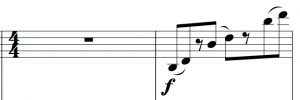The lyrics of “Eleanor Rigby” were somewhat of a collaborative effort, though ultimately Paul McCartney made all the final decisions, and is considered to be the primary author of the song. While the tune is quite compelling, if you strip away George Martin’s wonderful string octet arrangement, the chord progression is very basic, consisting only of E minor and C Major chords. Today we will be looking at the song from the perspective of what Pat Pattison would call a three verse story.
Songs that tell a story are hardly unique. However, ones that tell a captivating story are a treasure. The best way to create a story that is engaging is to get the listener to be more invested with each passing verse. Pattison refers to this process as stacking verses. “Eleanor Rigby” is personally my favorite example of this. In order to fully appreciate this, we have to approach the song imagining that we are listening to it for the first time without any prior knowledge.
The first verse introduces the title character, a probable romantic (picking up “rice in the church where a wedding has been”) who “lives in a dream.” The verse also leaves us with more than a bit of mystery about Rigby through the cryptic line “wearing the face that she keeps in a jar by the door.” This metaphoric reference to makeup is rendered more interesting by noting that it is kept near the door, begging the question why. The mystery is further established by ending the verse with the question, “Who is it for?” It is a question, by the way, that the song never answers (leaving it to our collective imaginations).
We can easily imagine Rigby waiting “at the window” for someone who we are left to assume does not come (suggested by the chorus “all the lonely people”). Is she expecting a caller who does not come? Is she hoping she will see the object of her devotion in the street? Does he know she exists? Again, none of these questions are answered, though the chorus suggests Rigby’s primary motivation may be desperation.
The second verse however abandons this sympathetic character. Instead, it moves on to Father McKenzie. This clergyman seems less desperate (and thus less sympathetic) than Rigby. In fact, the last line of of the verse, “what does he care?” leaves us with a sense of indifference.
Dramatically, the second verse is a significant step down from the first. While there’s some good imagery (“darning his socks in the night when there’s nobody there”), the character in the verse is significantly less sympathetic. Furthermore the only tenuous connection between the two characters (at this point) is both of them have a connection to a church.
This step down in drama sets up the sucker punch of the third verse when the connection between two characters is revealed, namely that Father McKenzie conducts Eleanor Rigby’s funeral. The lonely desolation of the first verse is intensified by specifying that Rigby was, “buried alone with her name,” and that “nobody came.” The final bleak nail in the coffin (pun intended) comes when the lyrics note that, “no one was saved.” Or, to put it another way, since no one attended Rigby’s funeral, no one was there to learn a lesson.
This three verse story is particularly effective, by setting up the sympathetic Rigby, moving away from her in a somewhat cinematic matter to the seemingly unrelated Father McKenzie, and then connecting these two lonely characters through the death of the Rigby. The third verse effectively pays off the emotional investment made in the first verse. Furthemore, the song invests in the audience through questions. When the chorus asks “where do they all come from?” and “where do they all belong?” it directly addresses and confronts the audience, forcing them to take ownership in the plights of Rigby and McKenzie, as well as any lonely people that may be known to the listeners.

